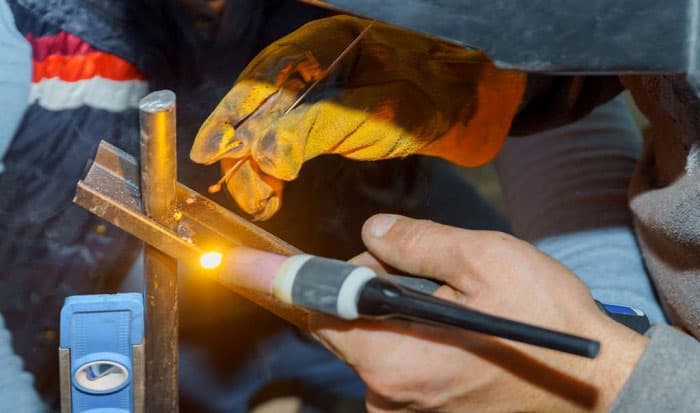What are heat resistant gloves made of? This is a common question among many. Some might be rookies handling molding, casting, or forging. They might look for a good protective piece to equip themselves for their first tasks. Others might be homeowners seeking gloves for dealing with a hot oven.
The use of these safety gloves is plentiful. And they are able to work as intended primarily because of the temperature-resistant fabrics. Read on to know more about these gloves.
Table of Contents
What Do Heat Resistant Gloves Mean?
Heat resistant glove definition is simple enough. It is a piece of protective equipment that keeps hands safe from any hazards involving high temperatures and hot items. Therefore, heat-resistant gloves are products used to shield against direct exposure to heat sources and minimize their harmful effect.
What Glove Material Is Heat Resistant?
There are several options of materials for constructing heat-resistant gloves. Here’re the most common ones available:
Terry Knit – Gloves made of Terry Cloth are typical for protection against heat and flame. They can shield against contact with hot items up to 450°F, translating to an ANSI heat-resistance level 3. With reinforced lining, some Terry Cloth gloves can protect against flame, with an ANSI rating level of 4.
Blue Terry Cloth is often heavier than the white kitted one and better at protecting against flame.
Furthermore, these resilient fibers can also resist cut and abrasion well. Some of the best Terry knit gloves can have an ANSI cut level of 7. They are indeed durable for long-lasting use, and some can absorb grease and oil rather well.
Synthetic materials (Kevlar and Neoprene) – These materials are reliable for producing heat-resistance gloves at temperatures higher than 450°F. That means gloves made of synthetic materials can have an ANSI heat resistance rating level 4 and above.
- Kevlar gloves are well-known for their heat, abrasion, and cut resistance properties. Due to the strong shield against cutting, these gloves are used to make oven mitts.
- Notably, Kevlar is also utilized as a reinforcement shell or lining for Terry Cloth work gloves. It adds protection to the pair and raises the level of protection as high as 800°F, twice the original protection property of the latter fabric.
- Neoprene work gloves are excellent for use against moist heat. It is because this material can resist chemicals well, and thus is often worn for chemical transfer. They are preferred in tasks involving hot liquids, steam, etc. Furthermore, it is best to choose neoprene work gloves with fleece lining.
- In addition, neoprene and nitrile are often used to coat knit gloves that resist high heat.
- There are fiberglass gloves used for welding, kilns, glass, blowing, and more as they are often designed for heat resistant gloves industrial Fiberglass is a material with a burning point of 1000°F. Work gloves made of this material paired with other reinforcement in coating and lining can withstand up to 2000℉.
Finally, leather gloves can resist heat and flame when lined with Kevlar. Aluminized gloves are also available with a coating to work near molten metal and high-heat furnaces.
How Do We Measure Heat Ratings of Work Gloves?
The American Society for Testing and Materials (ASTM) performs heat tests. It provides ratings for workers to purchase the proper protective pieces.
According to ASTM, there are six levels of conductive heat ratings for work gloves, which are the following:
| Level | Maximum temperature (in 15 seconds) before burnt |
| 0 | <176°F |
| 1 | 176°F |
| 2 | 284°F |
| 3 | 392°F |
| 4 | 500°F |
| 5 | 608°F |
What to Consider When Choosing Heat-resistant Gloves?
It is clear what heat resistant gloves uses are. But, not all gloves are created equal, and not all workplaces require the same kinds of gloves. Here is what you should pay attention to when selecting a pair:
- Dry and moist heat sources – As stated above, neoprene work gloves will be more suitable for moist heat hazards. Meanwhile, Terry Knit gloves are better when dealing with dry sources.
- Thermal and ambient heat – There are different protection levels for thermal and ambient heat. Different gloves allow you to touch the heat source and work near it in different temperature ranges.
- Spark and flame – You will need to check work gloves with flame resistance if you want to deal with open flame. Please know that protection against heat and flame are not the same things.
Conclusion
What are heat resistant gloves made of? There are indeed many options, including ones made of Terry cloth or synthetic fabrics like Kevlar, neoprene, or fiberglass. You can also find heat-resistant gloves with leather material and Kevlar linings.
Therefore, choosing the right gloves can be tricky if you do not know what your current working conditions require. So, make sure to check the requirements before matching them with the glove materials and other features.
Also, feel free to contact us regarding any questions or share the article. Thank you for reading.

This is Edward Manning, the editor in chief of Construction Informer. Quite a bit of my time is spent researching the market and interviewing experts in the field so that I can give you reliable information.




